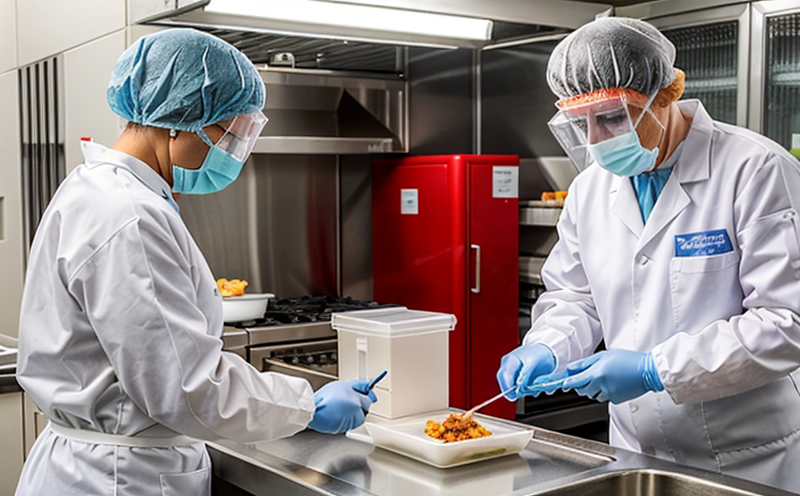FDA BAM Chapter 34 Detection of Viral Contamination in Frozen Vegetables
The FDA's Bacteriological Analytical Manual (BAM) Chapter 34 provides a standardized method for detecting viral contamination in frozen vegetables. This method is crucial for ensuring product safety and compliance with international standards such as ISO, EN, and ASTM.
The procedure outlined in FDA BAM Chapter 34 involves several critical steps including specimen preparation, extraction, concentration, and detection using molecular techniques like RT-qPCR (Reverse Transcription Quantitative Polymerase Chain Reaction). This method is particularly sensitive and can detect even trace amounts of viral contamination, making it indispensable for quality control.
The importance of this service cannot be overstated in the context of food safety. Frozen vegetables form a significant part of the diet across many countries, and any contamination with harmful viruses could pose serious health risks. By adhering to FDA BAM Chapter 34, laboratories ensure that frozen vegetable products meet stringent safety standards.
The process begins with proper sampling, which is critical for accurate results. Samples are then processed through a series of steps including homogenization and filtration to prepare them for extraction and concentration. Once the viral RNA or DNA is extracted, it undergoes reverse transcription and amplification using real-time PCR techniques.
Accurate detection requires precise instrumentation such as qPCR machines from reputable manufacturers like Applied Biosystems or Thermo Fisher Scientific. These instruments are capable of providing high sensitivity and specificity in detecting minute amounts of viral contamination.
The acceptance criteria for this method are stringent, with thresholds set to ensure that even the slightest hint of a contaminant is flagged. This ensures that no contaminated product reaches the market, thereby protecting public health.
Given its importance, FDA BAM Chapter 34 has been widely adopted globally and is often used in conjunction with other testing protocols. Compliance with this standard not only enhances brand reputation but also ensures regulatory compliance which is essential for maintaining a competitive edge in the food industry.
| Virus | Transmission Route | Symptoms |
|---|---|---|
| Adenovirus | Contact and Fecal-oral Route | Fever, Cough, Runny Nose |
| Hepatitis A Virus (HAV) | Fecal-oral Route | Jaundice, Fatigue, Abdominal Pain |
| Ebola Virus | Bloodborne and Fecal-Oral Route | Vomiting, Diarrhea, Bleeding |
Why It Matters
The detection of viral contamination in frozen vegetables is not just a regulatory requirement but also a critical component of ensuring public health and safety. Viral contamination, if undetected, can lead to serious health issues affecting consumers worldwide.
Quality managers must ensure that their suppliers adhere to the highest standards of hygiene and safety. By choosing FDA BAM Chapter 34 for testing, they can rest assured that any potential viral contaminants are identified early in the supply chain process. This proactive approach not only protects public health but also strengthens brand reputation.
Compliance with this standard is essential for food manufacturers aiming to meet international standards and maintain a competitive edge in the global market. By ensuring that their products meet these rigorous testing protocols, companies can differentiate themselves from competitors who may lack such stringent quality control measures.
Competitive Advantage and Market Impact
Adhering to FDA BAM Chapter 34 provides significant competitive advantages in the food industry. Consumers are increasingly concerned about the safety and quality of their food products, making it essential for manufacturers to demonstrate adherence to stringent testing protocols.
By offering FDA BAM Chapter 34 detection services, laboratories can position themselves as leaders in food safety and quality assurance. This not only enhances brand reputation but also fosters trust among customers who value product safety.
The market impact of this service extends beyond individual companies to the broader industry. By setting a high standard for viral contamination testing, FDA BAM Chapter 34 ensures that all products in the market meet the same stringent criteria, thereby enhancing overall consumer confidence and safety.
Use Cases and Application Examples
- Testing raw materials before processing to ensure they are free from viral contamination.
- Monitoring production processes at various stages to detect any potential sources of contamination.
- Sampling finished products for final quality checks before distribution.
- Investigating complaints or recalls by conducting targeted testing on suspected batches.
The FDA BAM Chapter 34 method is widely used in the food industry, particularly in sectors dealing with frozen vegetables. This ensures that all products meet strict safety standards and can be traced back to their source if necessary.
| Stage | Sample Description |
|---|---|
| Raw Materials | Fresh vegetables before processing. |
| Processing Line | Processed batches at various stages of production. |
| Finished Product |





